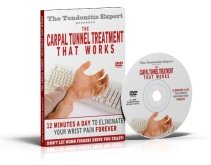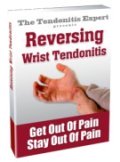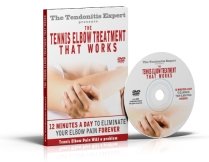Some Thoughts On Carpal Tunnel Exercises
Let's get a few quick questions out of the way first.
Are Carpal Tunnel Exercises, (Carpal Tunnel Stretches, really) effective?
Yes, they absolutely can be. If done the right way. Unless your symptoms are from nutritional insufficiency.
Will they fix the problem?
Not likely, though they potentially can if you work with your body -just right-.
But they can definitely help keep your structure more happy and healthy than it would be without them.
If I did appropriate stretching while I was working on the keyboard/mouse/knitting needles/haircutting shears, could I avoid getting Carpal Tunnel Syndrome in the first place?
Everybody is different and I can't make promises, but IF you stretch just the right amount in just the right way, you absolutely CAN keep your muscles loose enough and your nervous system relaxed enough to avoid getting Repetitive Strain Injury and/or avoid getting Carpal Tunnel Syndrome. (But you can't forget about nutrional requirements.)
Are Strengthening Exercises good for my Carpal Tunnel?
Yes or No.
It depends on what exactly you do and how far along your Carpal Tunnel Syndrome is.
Now let's expand on those answers.
Are Carpal Tunnel Exercises Effective?
Yes they are. At least, they can be.
"Movement is Life", as they say. Pain shows up when our body can't move optimally.
All Tendonitis and Carpal Tunnel Syndrome are 'lack of movement' injuries/issues.
See: What Is Tendonitis?
The irony is that both these issues are caused (partially) by too much movement, now commonly called Repetitive Strain Injury (RSI).
We need to look at your pain at a deeper level to understand.
RSI is muscles firing over and over and over, getting tighter and tighter, with micro-trauma rips and tears happening again and again and again.
Over time your muscles and connective tissue become more like a dry, crunchy, half-squeezed sponge.
What happens when you squeeze a dry, crunchy sponge?
It crackles, breaks, and is hard to squeeze.
Your structure is supposed to be soft and squishy so it can be supple and mobile and have lots of easy flowing circulation.
The more dry and crunchy your structure is, the less it actually moves...but it has to work harder to achieve less, and everything around it has to work harder to compensate
You tell it to move, and it does it's best, but, well, it's dry and crunchy and at least small parts of it -can't- move anymore.
Now it has a 'Lack of Movement' problem.
This means less circulation, less nutrition, and less ability to happily do the job.
Lack of Movement therefore helps create the rest of the Symptoms of Carpal Tunnel, like pain, reduced range of motion, numbness, more tightness, etc.
Stretching doesn't just stretch muscle. It stretches the connective tissue that wraps every bit of muscle.
Imagine that stretching is like squeezing a sponge.
Every time you stretch, the sponge gets squeezed, stretched out, and moves good fluid into the newly open space. And bunched fibers get unbunched (if only for a moment)
What happens when you repeatedly squeeze a dry sponge under a flow of water?
It gets soft and squishy.
All that dryness and crunchiness effectively disappears.
Stretching, used as a Carpal Tunnel Exercise, can help the dry crunchy sponge of your Tendonitis and Carpal Tunnel Syndrome become loose, soft, and squishy.
What's the right stretch?
It doesn't really matter.
It does of course, but really, any way you stretch, as long as you do it often, regularly over time, and without causing pain, is going to beneficially reshape your injured structure.
"So stretching will reshape my injury, but.......
Will Carpal Tunnel Exercises 'Fix' The Problem?
They can. But there are a lot of variables.
At a minimum, wrist and hand stretches can help reduce the tightness and the pain.
At best, you can totally reverse the Wrist Tendonitis and/or the Carpal Tunnel you are experiencing.
If you stretch often and regularly, meaning at least ten short (1-4 minute) stretch sessions a day, everyday until the pain is gone, you stand a very good chance of getting out of pain and staying out of pain.
Even if you are still using your hands every day.
If you are currently in severe pain, however, you must be careful not to irritate the inflammation. Stretch LIGHTLY and EASILY.
Still, if you are in severe, acute pain, you should hold off on the Carpal Tunnel Exercises and Stretches until you decrease the pain in the smartest way possible....by Reducing Inflammation.
FIRST read the Inflammation page and follow it with the page about How To Reduce Inflammation.
Then when you are down to Mild or Moderate pain, begin Carpal Tunnel exercises, both stretches and strengthening.
If I Did Appropriate Carpal Tunnel Exercises While I....
If I did appropriate Carpal Tunnel Exercises while I was working on the keyboard/mouse/knitting needles/haircutting shears, could I avoid getting Carpal Tunnel Syndrome or Wrist Tendonitis in the first place?
Yes.
Absolutely.
Without Doubt or Debate.
Again, every person and every situation is slightly different, but when you understand what Repetitive Strain Injury 'injury' is, you can use Carpal Tunnel Exercises to easily avoid it.
Are Strengthening Exercises Good For My Carpal Tunnel?
Yes, or No.
It depends how you do it and how far along the dynamic of your Carpal Tunnel Syndrome is.
If you have no pain or problem, Strengthening Exercises are a brilliant tactic that will help you do more work with little to no strain.
If you have moderate to severe pain and numbness, then Strengthening Exercises are not for you right now. Get out of pain first then once you are down to mild symptoms start strengthening exercises.
If you are somewhere in between 'none and 'moderate to severe', light weights and full range of movement should do much more good than harm, so it's worth starting.
Still, I would incorporate it with other vital activities you will find on this site, like How To Reduce Inflammation
Carpal Tunnel Exercises
Oh.....where to begin.
There are lots of different stretches and strengthening exercises.
You don't need to do them all. You just need to do a couple of them, the RIGHT way.
I'm not going to show you everything that's out there. I'm just going to show you the options I suggest my clients use for best and fastest results.
Stretches
It's actually more important that you understand HOW to stretch in a way that is safe for your Tendonitis.
I've been using the word 'stretch' up to this point. I'm now going to change the wording.
Because you do not want to 'stretch'. You want to 'lengthen'.
Stretching is to pull something apart.
Lengthening is to make something longer.
Stretching can injure you and increase your symptoms.
Lengthening works gently with your nervous system to make tight muscles loose, relaxed, and able to get more circulation.
Carpal Tunnel Exercises
The Danger of Stretching
If you have Tendonitis, you are in pain (even if you don't feel it and) your nervous system is on edge and guarding you.
If you stretch your injured, guarded structure, the nervous system will feel pain. If it feels pain, it will protect you by tightening up even more, and possibly increasing the amount of Inflammation in the area.
Depending on how old and/or how severe your situation is, stretching can also cause more damage to your already damaged structure.
You want to avoid this at all costs.
Carpal Tunnel Exercises
So What Is Lengthening?
Lengthening is the opposite of 'No Pain, No Gain'.
Lengthening is the opposite of stretching till it hurts.
Lengthening is to make something longer, to create more space, without the shearing, pulling-apart action of Stretching.
Try this to experience what I mean.
1. Straighten your pointer finger.
2. Stretch it back until you feel pain.
3. Now, never, ever do that again.
Now try this.
1. Straighten your pointer finger.
2. Slowly, gently, move it backwards until you feel the smallest, tiniest bit of resistance (the muscles just starting to create tension).
2b. It's very likely that just the act of pulling your finger to a straight position will have you feel muscular tightness/resistance in your finger.
Great. Start there.
3. Hang out at that first bit of muscular resistance for about five seconds, then lengthen back a little bit farther untill you feel the next bit of muscular resistance. Hang out for 5 seconds.
4. Repeat steps 1-3 often throughout the day.
Lengthening works.
Instead of sending pain messages to an already worried nervous system, Lengthening works -with- the nervous system, making it feel safe, coaxing it to allow tight muscles to relax.
Lengthening can help reset how much tone (tightness) the nervous system keeps a muscle set at.
You can take this lengthening concept into any stretching activity and body part.
Remember. The body does not like the sensation of pain.
You don't want it to feel pain.
In the context of Carpal Tunnel Exercises, Lengthening is a very effective way to get the results that you've been trying to get with Stretching.
Strengthening
Strengthening would have been a really good thing to do long -before- you developed Inflammation, a Pain Causing Dynamic, and Carpal Tunnel and/or Tendonitis.
It's never to late to start.
But.
But if you're experiencing more than 'some' pain, let's get the pain gone before you go doing any Strengthening Exercises.
Remember, the nervous system does not like the sensation of pain. It's already compensating for it, and if you cause more sensations of pain doing Strengthening exercises, your nervous system WILL respond in ways that you don't want.
Strengthening itself is not harmful, when done appropriately, but it can irritate a pre-existing dynamic like Carpal Tunnel Syndrome or Tendinitis.
Every action you perform takes a certain amount of strength.
Perform that activity over and over, as in the case with Repetitive Strain Injury, and you need a certain amount of strength -and- endurance to maintain a certain level of strength.
This is where Carpal Tunnel Exercises, specifically Strengthening, become very, very vital at avoiding and reducing pain and injury.
The Stronger you are...
The stronger you are, the less risk you have of becoming injured.
Here's why.
Remember I said every activity requires a certain amount of strength?
* If you are stronger than the job requires, you will be able to perform that job without injury.
* If you are exactly as strong as the job requires, you will experience fatigue and get wear and tear injury.
* If you are less strong that the job requires, you will quickly experience fatigue and get wear and tear injury.
You want to do strengthening carpal tunnel exercises before you hurt yourself doing a repetitive activity, or if you already missed that window, use the resources you find on this website to get out of pain, then start strengthening exercises as described below.
Return to the top of this Carpal Tunnel Exercises page.
Go to the Carpal Tunnel Syndrome page.
Go to the main Tendonitis page.
Go to the TendonitisExpert.com homepage.
| Share Your Story
|




